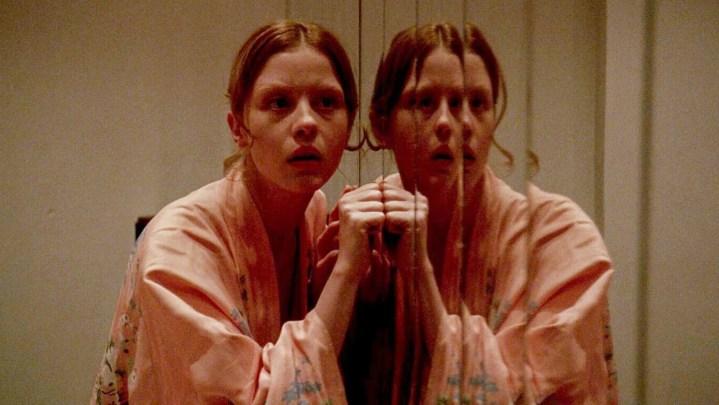
Even for a renowned filmmaker like Luca Guadagnino, remaking one of the most beloved and iconic horror films in history is not an easy thing to do. However, only one year later Call Me By Your Name launching it to the top of the international film scene, that’s what the director did. Assembling a crew of talented collaborators, including Dakota Johnson, Tilda Swinton, modern Scream Queen Mia Goth, and Radiohead’s Thom Yorke, Guadagnino set out in 2016 to finally create his own interpretation of Dario Argento’s giallo horror classic, Suspicion.
The resulting film, a drab operatic exploration of supernatural horror, looks and feels like a reverse of Argento’s original film, rather than a straight remake. Guadagnino’s Suspicion eschewing many of the defining aspects of its predecessor — namely the bright color palette, surrealist direction, and prog rock score. For these reasons, the film proved to be somewhat divisive, and its box office earnings still fell short of expectations. As of 2018, the general consensus seems to be that the remake was a bold, if not entirely successful, creative experiment for Guadagnino.
Five years later, achievements Suspicionone of the best horror films on Prime Video, seems clearer now than before. Time has lifted the fog of uncertainty that initially shrouded the film, and revealed that it is a refreshing spiritual successor to its predecessor, one that doesn’t so much build on what came before as complement it in a beautiful and haunting way. .

courtesy of Luca Guadagnino Suspicion sticks to the same basic plot as the 1977 original. The film follows Susie Bannion (Dakota Johnson), an ambitious young American girl, as she is accepted into a prestigious European dance academy, only to find herself manipulated and targeted by a secret group of witches. silently control it. As more of her fellow dancers begin to mysteriously disappear and die, Susie’s interest in the history of the academy and its hidden power structures grows.
Different from the original Suspicion, Guadagnino’s remake takes place specifically during the German Autumn of 1977, a period of kidnappings, murders, and political demonstrations that saw the long-simmering frustrations, resentments, and guilt of a still-divided postwar Berlin rise to the surface. The film, written by David Kajganich, spends too long on its historical setting, which doesn’t really relate directly to its magical main plot, but rather reinforces it thematically. Nevertheless, Autumn in Germany did more than just help 2018 Suspicion creating a suffocating atmosphere of crime and terror, but also fueling its subversive and chilling climax.
The film’s final act deviates significantly from the blueprint laid out by Argento Suspicion, which tells the familiar Final Girl horror story from start to finish. In Guadagnino’s version, Dakota Johnson’s Susie not only survives the horrors of the supernatural parasitic culture at her dance academy, but also holds those who lead her accountable. This last-minute narrative digression serves as a curious response to Autumn in Germany and an interesting contemporary update on the ending of the original film. Suspicion. Perhaps, Guadagnino’s Suspicion I think that’s not enough only survive.

Despite its thematic complexity, 2018 Suspicion plays as a stylish companion to its often hypnotic predecessor from 1977. The film is as visually desaturated and cold as the original Suspicion, in all its rich blues, pinks, and reds, is definitely not. Where Argento’s film delighted in employing its director’s surrealist architecture and inimitable visual style to trap its characters in overly elaborate death traps, Guadagnino’s remake relies on stomach-churning body horror and precise crosscutting as the primary means of death and destruction.
The film uses its dance academy setting — nothing more than the lingerie set in the 1977 original — as a source for its own witchy magic and horror events. There is a physicality to Guadagnino Suspicion which is largely absent in Argento, who transforms her characters’ female bodies into instruments of unmistakable beauty and death. Never has this been demonstrated more brutally than in the film’s most famous scene, which editorially links Johnson’s Susie’s dancing to the violent death of one of her school friends.
This creative choice pays off Suspicion recreates a compelling reinterpretation of Argento’s original work. The latter is a visually stunning, surreal exercise in cinematic horror. The pleasures are mostly formal and superficial. Guadagnino’s Suspicion, on the other hand, is more concerned with the externalization of interior spaces that distract from its characters. Over its 152-minute running time, the film emerges as more narratively ambitious and psychologically demanding than its predecessor, but no less bloodthirsty or expressively violent. Whatever your choice, if time has proven anything, it’s 2018 Suspicion deserves to exist alongside the classics that inspired it. Both offer experiences that are, in their own way, unforgettable.
Suspicion (2018) is streaming now on Amazon Prime Video.
Editor’s Recommendations